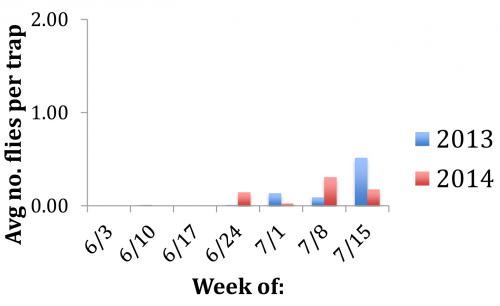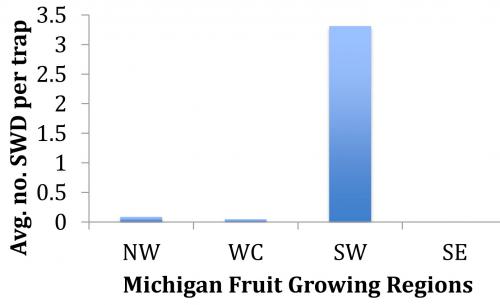Michigan spotted wing Drosophila report for July 15, 2014
Spotted wing Drosophila numbers are increasing in southwest Michigan; protect susceptible crops where they are detected.
This is the fourth weekly report of the Michigan State University Extension spotted wing Drosophila (SWD) statewide monitoring program for 2014. Our network of traps across more than 100 sites was checked during the week of July 8 and has revealed increased activity of this pest in southwest Michigan. There was a total of 75 males and 78 females trapped from the following Michigan counties: Berrien, near strawberries, blueberries, raspberries, tart cherries and peaches; Allegan, near blueberries, raspberries and tart cherries; Ottawa, near raspberries; Van Buren, near plums, tart cherries and grapes; Kent, near raspberries; Leelanau, near raspberries and tart cherries; and Antrim, near strawberries. Traps in our network are also set up, but did not catch any SWD this week, in Ionia, Mecosta, Ingham, Benzie, Grand Traverse, Livingston, Oakland, Macomb, Lapeer, Genesee, Montcalm, Muskegon and Oceana counties.
Comparison of average trap catches by week between 2013 and 2014.

Comparison of average SWD adults captured per trap by region. Northwest (NW) counties include Antrim, Grand Traverse, Benzie, and Leelanau; west central (WC) counties include Ionia, Kent, Mecosta, Montcalm, Muskegon, and Oceana; southwest (SW) counties include Allegan, Berrien, Ottawa, and Van Buren; southeast (SE) counties include Genesee, Ingham, Livingston, Macomb, and Oakland.

While a majority of traps in the network (82 percent) still caught no SWD, of the traps that did catch SWD, some caught as many as 22 flies per trap with an average of six flies per trap compared with about 1.5 flies on average over all the traps in the network. Many of the traps that caught higher numbers of flies are near woodlots where wild berry-producing shrubs such as honeysuckle are reported to have an abundant crop of berries due to good soil moisture this season. In other areas, SWD numbers are still generally low, but this highlights that growers should continue to be on alert for this pest as their susceptible fruit crops start or continue to ripen.
SWD can only infest berries when they are ripening or ripe, so currently the focus of SWD monitoring and management efforts should be in susceptible fruit that should be treated only if SWD are detected to minimize the risk of developing pesticide-resistant populations of SWD. In addition to the use of monitoring traps to detect the adult flies, a simple salt solution of 1 cup of salt per gallon of water can be used to assess fruit for larval infestation.
For more information on SWD monitoring and management strategies, and to read past reports, visit MSU‘s Spotted Wing Drosophila website.
The weekly SWD statewide monitoring report has been funded through Project GREEEN and Michigan State University Extension. This output is generated through a network of MSU Extension field staff and campus specialists. We would like to acknowledge the following team members and thank them for their weekly scouting efforts and input into this report: Rufus Isaacs, Keith Mason, Steve VanTimmeren, Larry Gut, Peter McGhee, Michael Haas, Bob Tritten, Mark Longstroth, Brad Baughman, Carlos Garcia, Karen Powers and Nikki Rothwell.
Dr. Isaacs’ work is funded in part by MSU‘s AgBioResearch.



 Print
Print Email
Email

